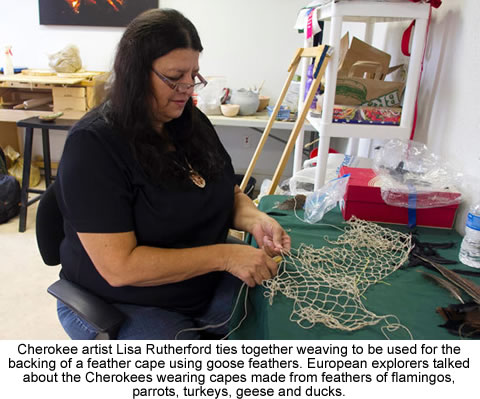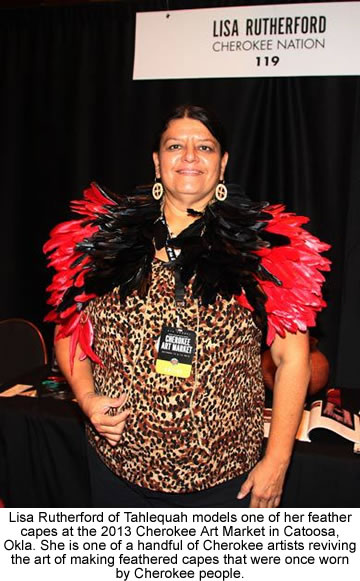 |
Canku Ota
|
 |
|
(Many Paths)
|
||
|
An Online Newsletter
Celebrating Native America
|
||
|
January 2014 - Volume
12 Number 1
|
||
|
|
||
|
Rutherford Recreating
Cherokee Feathered Capes
|
||
|
by Will Chavez - Senior
Reporter, Cherokee Phoenix
|
||
|
credits: photos by Will
Chavez - Cherokee Phoenix
|
|
Rutherford said pottery is her primary art form, learning from Cherokee National Treasure Jane Osti of Tahlequah. However, she also studied Southeastern-style beadwork with Cherokee National Treasure Martha Berry of Tyler, Texas. And somewhere along the way, some Eastern Band of Cherokee Indians friends sparked her interest in 18th-century Cherokee clothing, helping her create outfits from that period. She now demonstrates making traditional Cherokee arts at shows and other events dressed in 18th-century Cherokee clothing. But while researching Cherokee clothing and how tribal pottery was stamped with textiles she became interested in feather capes that were once worn by Cherokee people.
So far Rutherford has only used goose and turkey feathers for her capes but wants to try other feathers such as pheasant. She places lighter-colored feathers among darker feathers on her capes to create accents. Rutherford teamed up with Cherokee National Treasure Tonia Weavel of Tahlequah to learn how to make capes and mantles. Based on her research, Rutherford believes a mantle is longer and requires more feathers while a cape is shorter and mainly covers one's shoulders. "We (she and Weavel) got together and decided if our ancestors could figure this out we can make one. So we borrowed a cape a museum professional had made in Pennsylvania and we studied the thread pattern. It was really hard. It took us six days to learn how to weave that. I finally wove one. I was able to make my first feather cape," Rutherford said. Along with weaving the netting, finding good feathers is challenging, Rutherford said. And they can be expensive. A pound of dyed, sanitized goose feathers costs $80. After culling a pound of feathers, she said she might throw half of them away because they do not meet her standards.
One of her hip-length mantles has approximately 2,200 feathers. She said the capes and mantles are warm and likely had practical
use for Cherokee people to help keep them warm in cold weather.
In her research she has found only Cherokee men wore the mantles. Rutherford said she she wants to branch out into painting, but only after filling her cape orders. "You have to do what sells when you're a full-time artist even though you'd like to do something more fun. You have to budget your time and balance your priorities." Since learning the craft in 2011, Rutherford has made 10 capes
and has customer orders for five others. "They've been very popular," Rutherford said. "I've sold several to Eastern Band contestants for Miss Cherokee. I've sold some for exhibits." |
|
|
||
|
|
||
| Canku Ota is a free Newsletter celebrating Native America, its traditions and accomplishments . We do not provide subscriber or visitor names to anyone. Some articles presented in Canku Ota may contain copyright material. We have received appropriate permissions for republishing any articles. Material appearing here is distributed without profit or monetary gain to those who have expressed an interest. This is in accordance with Title 17 U.S.C. Section 107. | ||
|
Canku Ota is a copyright ©
2000 - 2013 of Vicki Williams Barry and Paul Barry.
|
||
 |
 |
|
|
The "Canku
Ota - A Newsletter Celebrating Native America" web site and
its design is the
|
||
|
Copyright ©
1999 - 2013 of Paul C. Barry.
|
||
|
All Rights Reserved.
|
||
 TAHLEQUAH,
OK– Lisa Rutherford's studio space in the Cherokee Arts Center
is a testament to her artistic interests. Her pottery in the room
mixes with her textile and beadwork. Also in the room are loose
goose feathers that are to be part of capes she's creating because
she's one of a handful of Cherokee artists who can make feathered
capes and the only one currently doing so.
TAHLEQUAH,
OK– Lisa Rutherford's studio space in the Cherokee Arts Center
is a testament to her artistic interests. Her pottery in the room
mixes with her textile and beadwork. Also in the room are loose
goose feathers that are to be part of capes she's creating because
she's one of a handful of Cherokee artists who can make feathered
capes and the only one currently doing so.  "The
Eastern Band had feather capes, and I wanted one too to go with
my 18th-century clothing," she said. "(Hernando) de Soto described
these capes as early as 1540. He described different feather mantles
and capes. Different explorers talked about the Cherokees wearing
them as late as the 1700s. They were described as being on a net
base with the brightest colored feathers from flamingos, parrots,
turkeys, geese, ducks – the brighter colors were the preferred
colors."
"The
Eastern Band had feather capes, and I wanted one too to go with
my 18th-century clothing," she said. "(Hernando) de Soto described
these capes as early as 1540. He described different feather mantles
and capes. Different explorers talked about the Cherokees wearing
them as late as the 1700s. They were described as being on a net
base with the brightest colored feathers from flamingos, parrots,
turkeys, geese, ducks – the brighter colors were the preferred
colors."  "It
just takes a lot of time. You have to individually bend the quill
on each feather and bend over a wire to make a nice round eye to
sew through, and then you lash them down," she said. "There are
probably 750 to 800 feathers in a (over the shoulder) cape, so it
takes a significant amount of time."
"It
just takes a lot of time. You have to individually bend the quill
on each feather and bend over a wire to make a nice round eye to
sew through, and then you lash them down," she said. "There are
probably 750 to 800 feathers in a (over the shoulder) cape, so it
takes a significant amount of time."